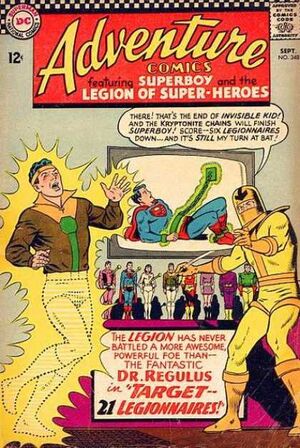My pleasure reading these days includes old Legion of Super-Heroes stories and reviewing them for the Legion World message board. It’s always risky to go back and re-read stories you grew up on. They may not live up to the hype imposed by memory and childhood wonder.
However, revisiting old stories can also produce insights for writers. We can learn from the choices previous
writers made, both good and bad.
Two recent re-reads, for example, helped clarify in my mind
the relationship between character and plot—specifically why plot should emerge
from the characters instead of the other way around.
In looking at these two stories, we can get a sense of
how not to treat our characters like puppets of the plot.
“Target—21 Legionnaires” (Adventure Comics # 348, September 1966)
This story was written by Jim Shooter, who made
comics history when he became the regular Legion writer at the age of 14. Shooter was roughly the same age as the
Legionnaires he wrote and so he was able to bring a lot of realism to their
personalities and dialogue. Shooter also
created many of the Legion’s most memorable villains, including, in this issue,
Dr. Regulus.
However, Shooter was still developing as a writer, and that
explains why certain actions in this story are not wholly believable.
Dr. Regulus, a disgraced scientist who harnesses the power
of gold, holds a vendetta against a particular Legionnaire, Sun Boy, and
arranges for the latter to suffer from amnesia while Regulus steals the
Legion’s clubhouse headquarters. However, the other Legionnaires track Regulus down and board his massive
ship.
Here’s where the plot forces the characters to do a puppet-like dance.
 |
| Copr. and TM DC Comics Inc. |
As the Legionnaires separate to explore the ship, Colossal
Boy enters a room that is tailor made for him—it’s giant-sized. It also contains a giant robot that dukes it
out with Colossal Boy and ultimately overpowers him.
But what if Colossal Boy had entered some other room? Are we to believe every room on the ship
is giant-sized just to trap him? What if
Colossal Boy hadn’t been part of the Legion team that went after Regulus? The latter would have gone to all that
planning for nothing.
A few pages later, Cosmic Boy, whose power is magnetism,
becomes distracted by a noise and backs into a wall. Bad move, Cos. Gold bands emerge from the wall and ensnare
him, his power useless against gold.
What if Cos had backed against a different wall (we’re
not shown similar traps on other walls) or hadn’t touched a wall at all?
Meanwhile, the amnesiac Sun Boy wanders into a nuclear power plant, where he falls asleep. Not to worry, though. Atomic radiation (the source of his solar powers) restores his memory—and just in time, too, for he’s able to come to the rescue of his teammates aboard the ship.
I’m willing to grant the comic book logic that atomic
radiation can restore the memory of a character whose power was created by
atomic radiation. But I find it less
plausible that, of all the places Sun Boy could have snoozed, he happened to
find an unguarded nuclear power plant with an energy source that has been
carelessly left open.
There are more examples of coincidence ruling the plot. And it’s a shame because “Target—21 Legionnaires”
is an otherwise exciting story with several positive qualities (the realistic dialogue and personalities of the Legionnaires and a formidable villain being at the top of the list).
But because Shooter needed certain things to happen in the
story—the Legionnaires get captured, Sun Boy arrives to save the day—he has the
characters do things that fit the needs of the plot rather than behaving
in credible ways.
Perhaps we should give Shooter a pass for being so young
when he wrote the story (and, indeed, his talents as a writer are well evident here); however, Shooter had an adult editor, Mort Weisinger, who
should have known better.
In my next post, we’ll talk about the other story, published a mere few months earlier, in which the writer gets the balance between character and plot just right.



No comments:
Post a Comment